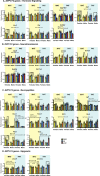Transgenerational effects of polychlorinated biphenyls: 2. Hypothalamic gene expression in rats†
- PMID: 33824955
- PMCID: PMC8444700
- DOI: 10.1093/biolre/ioab066
Transgenerational effects of polychlorinated biphenyls: 2. Hypothalamic gene expression in rats†
Abstract
Polychlorinated biphenyls (PCBs) are endocrine-disrupting chemicals (EDCs) with well-established effects on reproduction and behavior in developmentally-exposed (F1) individuals. Because of evidence for transgenerational effects of EDCs on the neuroendocrine control of reproductive physiology, we tested the hypothesis that prenatal PCB exposure leads to unique hypothalamic gene-expression profiles in three generations. Pregnant Sprague-Dawley rats were treated on gestational days 16 and 18 with the PCB mixture Aroclor 1221 (A1221), vehicle (3% DMSO in sesame oil), or estradiol benzoate (EB, 50 μg/kg), the latter a positive control for estrogenic effects of A1221. Maternal- and paternal-lineage F2 and F3 generations were bred using untreated partners. The anteroventral periventricular nucleus (AVPV) and arcuate nucleus (ARC), involved in the hypothalamic control of reproduction, were dissected from F1 to F3 females and males, RNA extracted, and gene expression measured in a qPCR array. We detected unique gene-expression profiles in each generation, which were sex- and lineage-specific. In the AVPV, treatment significantly changed 10, 25, and 11 transcripts in F1, F2, and F3 generations, whereas 10, 1, and 12 transcripts were changed in these generations in the ARC. In the F1 AVPV and ARC, most affected transcripts were decreased by A1221. In the F2 AVPV, most effects of A1221 were observed in females of the maternal lineage, whereas only Pomc expression changed in the F2 ARC (by EB). The F3 AVPV and ARC were mainly affected by EB. It is notable that results in one generation do not predict results in another, and that lineage was a major determinant in results. Thus, transient prenatal exposure of F1 rats to A1221 or EB can alter hypothalamic gene expression across three generations in a sex- and lineage-dependent manner, leading to the conclusion that the legacy of PCBs continues for generations.
Keywords: Aroclor 1221 (A1221); anteroventral periventricular nucleus; arcuate nucleus; endocrine-disrupting chemical; estrogen; hypothalamus; neuroendocrine; polychlorinated biphenyls; sex difference; transgenerational.
© The Author(s) 2021. Published by Oxford University Press. All rights reserved. For Permissions, please email: journals.permissions@oup.com.
Figures






Similar articles
-
Transgenerational effects of polychlorinated biphenyls: 1. Development and physiology across 3 generations of rats.Environ Health. 2018 Feb 20;17(1):18. doi: 10.1186/s12940-018-0362-5. Environ Health. 2018. PMID: 29458364 Free PMC article.
-
Disruption of reproductive aging in female and male rats by gestational exposure to estrogenic endocrine disruptors.Endocrinology. 2013 Jun;154(6):2129-43. doi: 10.1210/en.2012-2123. Epub 2013 Apr 16. Endocrinology. 2013. PMID: 23592748 Free PMC article.
-
Dynamic postnatal developmental and sex-specific neuroendocrine effects of prenatal polychlorinated biphenyls in rats.Mol Endocrinol. 2014 Jan;28(1):99-115. doi: 10.1210/me.2013-1270. Epub 2013 Jan 1. Mol Endocrinol. 2014. PMID: 24284824 Free PMC article.
-
Transgenerational neuroendocrine disruption of reproduction.Nat Rev Endocrinol. 2011 Apr;7(4):197-207. doi: 10.1038/nrendo.2010.215. Epub 2011 Jan 25. Nat Rev Endocrinol. 2011. PMID: 21263448 Free PMC article. Review.
-
Endocrine-disrupting chemicals: Effects on neuroendocrine systems and the neurobiology of social behavior.Horm Behav. 2019 May;111:7-22. doi: 10.1016/j.yhbeh.2018.11.006. Epub 2018 Dec 4. Horm Behav. 2019. PMID: 30476496 Free PMC article. Review.
Cited by
-
Transgenerational effects of alcohol on behavioral sensitivity to alcohol in Caenorhabditis elegans.PLoS One. 2022 Oct 18;17(10):e0271849. doi: 10.1371/journal.pone.0271849. eCollection 2022. PLoS One. 2022. PMID: 36256641 Free PMC article.
-
Two Hits of EDCs Three Generations Apart: Effects on Social Behaviors in Rats, and Analysis by Machine Learning.Toxics. 2022 Jan 11;10(1):30. doi: 10.3390/toxics10010030. Toxics. 2022. PMID: 35051072 Free PMC article.
-
Polychlorinated Biphenyls (PCBs) in the Environment: Occupational and Exposure Events, Effects on Human Health and Fertility.Toxics. 2022 Jul 1;10(7):365. doi: 10.3390/toxics10070365. Toxics. 2022. PMID: 35878270 Free PMC article. Review.
-
Endocrine-Disrupting Chemicals: Science and Policy.Policy Insights Behav Brain Sci. 2023 Oct;10(2):142-150. doi: 10.1177/23727322231196794. Epub 2023 Oct 26. Policy Insights Behav Brain Sci. 2023. PMID: 39758979 Free PMC article.
-
Cognitive effects of early life exposure to PCBs in rats: Sex-specific behavioral, hormonal and neuromolecular mechanisms involving the brain dopamine system.Horm Behav. 2025 Mar;169:105697. doi: 10.1016/j.yhbeh.2025.105697. Epub 2025 Feb 8. Horm Behav. 2025. PMID: 39923265 Free PMC article.
References
-
- Streifer M, Gore AC. Epigenetics, estrogenic endocrine-disrupting chemicals (EDCs), and the brain. Adv Pharmacol 2021; in press. - PubMed
-
- Krishnan V, Safe S. Polychlorinated biphenyls (PCBs), dibenzo-p-dioxins (PCDDs), and dibenzofurans (PCDFs) as antiestrogens in MCF-7 human breast cancer cells: quantitative structure-activity relationships. Toxicol Appl Pharmacol 1993; 120:55–61. - PubMed
-
- Hamers T, Kamstra JH, Cenijn PH, Pencikova K, Palkova L, Simeckova P, Vondracek J, Andersson PL, Stenberg M, Machala M. In vitro toxicity profiling of ultrapure non-dioxin-like polychlorinated biphenyl congeners and their relative toxic contribution to PCB mixtures in humans. Toxicol Sci 2011; 121:88–100. - PubMed
Publication types
MeSH terms
Substances
Grants and funding
LinkOut - more resources
Full Text Sources
Other Literature Sources
Miscellaneous

